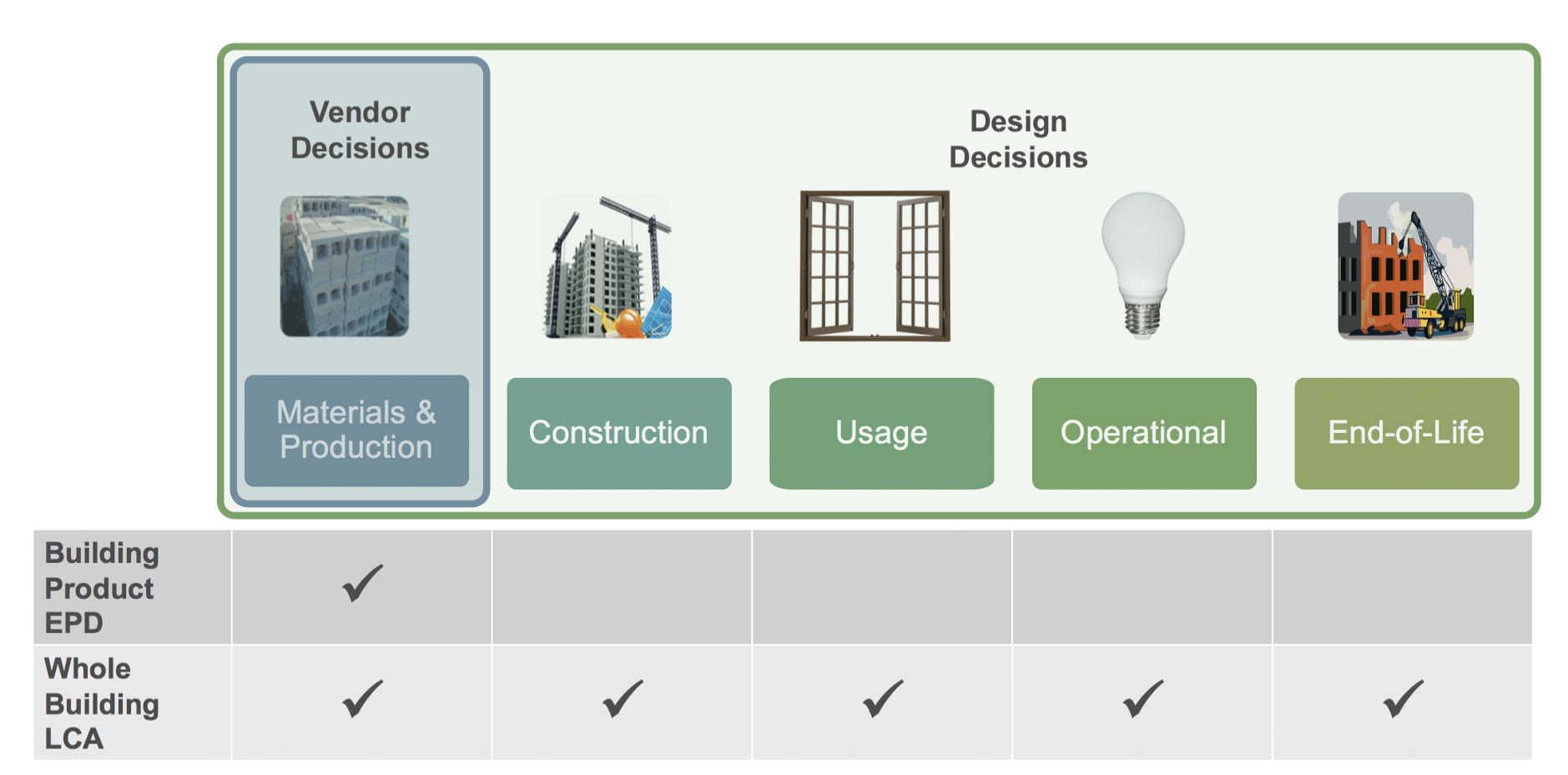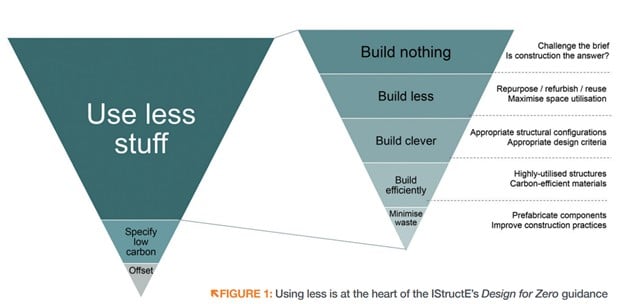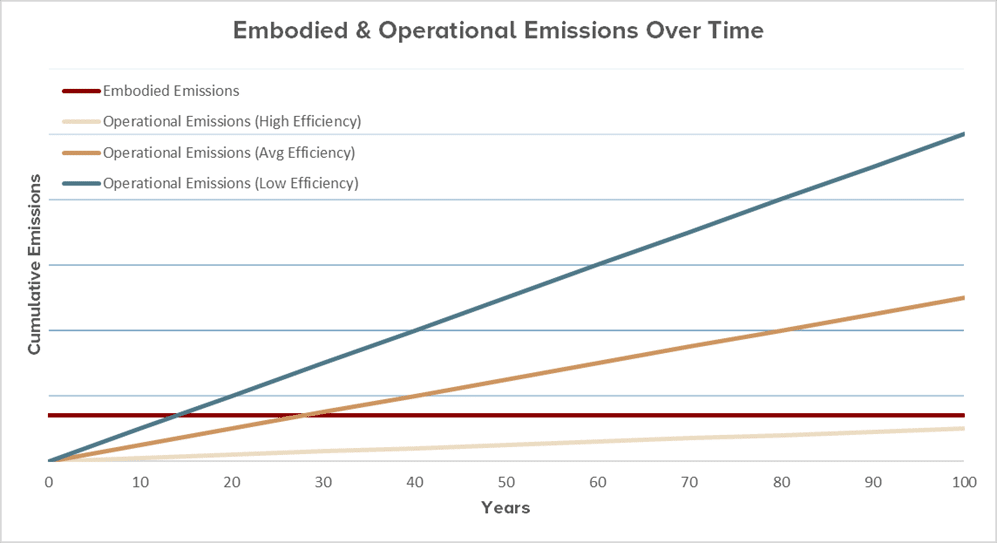
Embodied Carbon (that we prefer to call Embodied Emissions) is the new hot topic in the construction industry.
If you don’t know what embodied emissions are and want to learn more, you’re in the right place! This post is an introduction to the terms and lists simple strategies to start reducing embodied emissions today.
What are Embodied Emissions?
Together, building operations and construction are responsible for a total of 39% of global CO2 emissions. While 28% of these global emissions come from building operations (the energy used to heat, cool, light, and ventilate buildings), 11% comes from materials and construction. These are the greenhouse gas emissions associated with the extraction, manufacturing, transportation, installation, and decommissioning of building materials, often referred to as embodied emissions or embodied carbon. As new buildings are constructed to increasingly high energy efficiency standards, these embodied emissions will continue to account for an ever-growing portion of total emissions.
We’ve written another article on why embodied emissions matters that you can access here.
Where is the industry trending?
For the past few decades, governments and municipalities have focused their policies (if at all) on reducing operational emissions in new and existing buildings. As building science advances and more work is being done to bring embodied emissions into the spotlight, embodied emissions reporting and compliance is set to become a new standard in the future building code, just like energy efficiency standards such as the BC Energy Step Code most of us are familiar with today.
In fact, on October 1st 2023, the City of Vancouver will be introducing the first embodied emissions requirements of its kind for part 3 multi-unit and high-rise buildings, leading the way in establishing a set framework for measuring and reporting embodied emissions in new construction.
How do we measure embodied emissions?
Life Cycle Assessments (LCAs) are a widely known and well-established methodology for transparent and credible environmental accounting of a product or service throughout its entire life cycle.
Whole-building LCAs (WB-LCA), as the name suggests, quantify the environmental impacts over the lifespan of a building and help determine design decisions, which can consider all phases of a building’s life cycle.
Environmental Product Declarations (EPDs) are used as part of this process to gather emissions data on individual building materials, which are then input into the Whole-building LCA. EPDs are documents that transparently communicate the environmental performance or impact of any product or material over its lifetime. They are useful to compare the performance of different building products and make informed decisions on the most sustainable choice.
Embodied emissions are given as a value in CO2e, or carbon dioxide equivalent. Because some gases (such as methane) have a greater global warming potential, or warming effect, than carbon dioxide, the metric CO2e is used which means that greenhouse gases other than carbon dioxide can be converted, or normalized, to the equivalent amount of CO2, based on their relative contribution to global warming. CO2e provides for a single, uniform means of measuring emissions reductions for multiple greenhouse gases.
How to lower embodied emissions?
Source: Adapted by IStructE, Design for Zero from the World Business Council, 2021.
Through Design
One of the easiest ways to reduce embodied emissions is to follow the principle of only building what is absolutely necessary. Modest-sized homes are built using fewer resources and consume fewer resources to operate. The same can be said for simple designs, which eliminate excess framing and structural materials, reduce the surface area of the building, and aid in both embodied carbon and operational efficiency. Buildings can also be designed to fit into a circular economy with planned disassembly and reuse or recycling of materials as they reach the end of their useful life cycles.
Through careful material selection
Conscious material selection and substitutions for sustainable alternatives are crucial in building a home low in embodied emissions. Reclaimed materials are a great way to help prevent waste while saving on the upfront emissions associated with brand-new materials.
If certain materials can’t be completely substituted (for example concrete), there may be other ways in which the quantities can be reduced, for example; building a home on helical concrete piers rather than pouring a full concrete slab. Low-carbon concrete mixes are also more and more available at competitive prices.
Insulation products carry a broad range of emissions profiles and can account for a significant portion of emissions if not chosen carefully. Spray foam is known to be one of the worst offenders due to the high global warming potential of the blowing agents used. Conversely, products such as dense-packed blown cellulose or wood-fibre insulation are considered to be a form of carbon storage, a term that refers to materials that capture or sequester carbon during their growth.
Using carbon-storing materials is a great way to reduce the embodied emissions of a new build, even helping to offset emissions that might be more difficult to mitigate in other areas.
Through sourcing
Using locally and regionally sourced materials whenever possible has multiple benefits. Firstly, it helps to reduce the emissions associated with transport since shorter distances are traveled to deliver the materials, resulting in lower carbon emissions.
Secondly, it supports the local economy by promoting local businesses and creating job opportunities within the community.
What is truly Net Zero?
Many of the Net Zero standards for homes refer to Net Zero operational efficiency or a home that produces as much energy as it consumes on a yearly basis. For years, this has been considered the golden standard. While there is no doubt net zero is a great achievement in terms of operational efficiency, could it be possible that a net zero home may not always be the most sustainable choice?
As the field of sustainability develops and gives us a greater understanding of key concepts such as circularity and systems thinking, it becomes increasingly important to incorporate these concepts into all aspects of society, particularly the building industry which has always remained somewhat resistant to change.
The truth is that a home with net zero operational emissions could be built using unsustainably sourced materials, high in embodied emissions which have been shipped halfway around the world to their final destination. Conversely, a home with moderate operational emissions could be built using carefully chosen materials low in embodied emissions and locally sourced.
While the net zero home might typically be regarded as the ‘greener’ or more sustainable choice, the operational emissions savings that the net zero home provides would take years to equate to the upfront embodied emissions associated with building it. This concept of embodied carbon pay-off is illustrated in the graph below:
With the current net zero standard failing to consider the whole building as a system, perhaps the time has come for a new standard? One which takes a more holistic approach to considering the environmental impact of a building and provides a more accurate representation of what it means to build a truly sustainable, zero carbon home.
Want to start measuring the embodied emissions of your next build?



